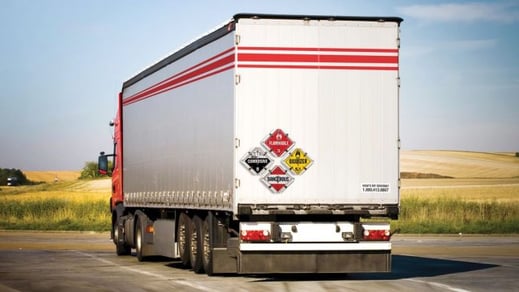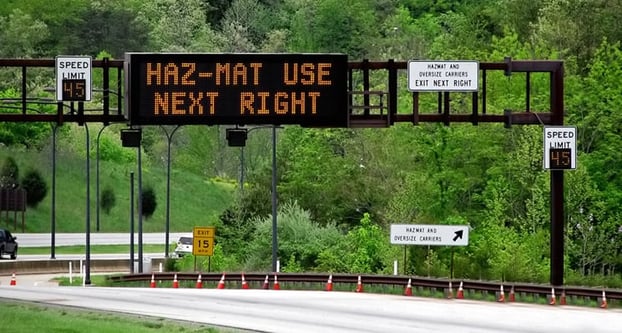REDWOOD LOGIN
Redwood PortalLTL
SCS
SCS Support
Rockfarm

There are nearly 500,000 shipments of hazardous materials in the U.S. every day, according to Don Boyd in Transportation of Hazardous Materials. Despite its prevalence, companies still don’t know how to properly manage their hazmat (hazardous materials) transportation.
Hazmat transport is a complex system with intricate rules and regulations. Manufacturers and shippers are often unaware of all of the minutiae of hazmat transportation management. This unfamiliarity can land companies with hefty fines, unsafe practices, bad publicity, legal problems, and even total business shut down.
Is your company hazmat compliant?
The goal of compliance is to prevent severe accidents that could be damaging to people, property, or the environment. Hazmat compliance helps to minimize any consequences that could jeopardize the business. It also ensures that there’s a timely emergency response set in place if an accident occurs while transporting or storing hazardous materials.
We’ll go through the standard regulations and laws regarding hazmat transportation management and what you can do to maintain compliance.
The Hazardous Materials Transportation Act (HMTA) was enacted in 1975. Throughout the early 70s, companies were dumping their hazardous waste in landfills. This led to high costs for disposal sites and safety concerns for workers and surrounding populace. Because of this, traditional landfills stopped accepting any hazardous waste.
Thus, companies began illegally dumping their hazardous waste in the middle of the night anywhere they could— as a way to quickly and cost-effectively get rid of their materials. They’d throw hazardous materials in vacant lots, on the side of roadways, and even directly on highways themselves. The cleanup of these materials put an enormous financial and labor burden on the government.
Consequently, the HMTA was passed as the principal U.S. federal law regarding the transportation and shipment of hazardous materials. The HMTA is part of the current EPA’s Emergency Management Program.
The purpose of the HMTA is to protect against spills and illegal dumping that endanger life, property, and the ecosystem. The Secretary of Transportation defines hazardous materials as any material that poses a risk to health and safety in commerce transportation. These materials can be:
• Explosive
• Radioactive
• Infectious
• Flammable
• Toxic
• Oxidizing
• Corrosive
The HMTA has four provisions under title 49 and HTMA has undergone two major amendments in 1990 and 1994. These have further complicated compliance and management for shippers and carriers. In addition, not all hazardous materials regulations are always aligned—so maintaining compliance can often feel like a guessing game. Nevertheless, every company must adhere to these rules, whether shipping hazardous material by road, rail, air, or water.

Violating the HMTA and HAZMAT compliances will land your company with civil and criminal penalties. Sometimes these fines can be so steep that they can put you out of business. Violations can stem from inaccurate or incomplete shipping papers; incorrect or lacking shipping descriptions; missing or incorrect HAZMAT placards; no package type or unit of measure for each entry; and more.
In order to maintain hazmat compliance, follow the basic following steps:
• Use the hazardous materials table to identify the hazard class, specific packaging requirements, and appropriate labeling for each shipment.
• Comprehensively complete the shipping papers with ID Number, SHapping Name (in hazardous materials table), Hazard Class, Packaging Group (in Roman numerals), Total quantity of materials, and number and type of packages holding hazmat
• Include an EPA manifest. This is a sheet that tracks the precise transportation of an individual package of hazardous materials. This data needs to be recorded at all ports, routes, stops, and destinations.
• Make response and security plans. This should include contact information as well as appropriate emergency reactions for each type of hazmat accident or incident.
Unfortunately, hazmat transportation management is much more complex than just that. In fact, some companies even hire a hazmat manager, whose sole job is to ensure hazmat compliance. (The salary of a hazmat manager is significantly less than the cost of even one potential hazmat accident.)
Don’t leave hazmat compliance or safety to chance. If you’re a shipper, producer, or manufacturer, you don’t want to worry about following these extensive hazmat regulations. Hire a transportation company like LTX Solutions, who is proficient and seasoned at following hazmat compliance. Contact us today to learn about our efficient, regulated, safety processes and services.